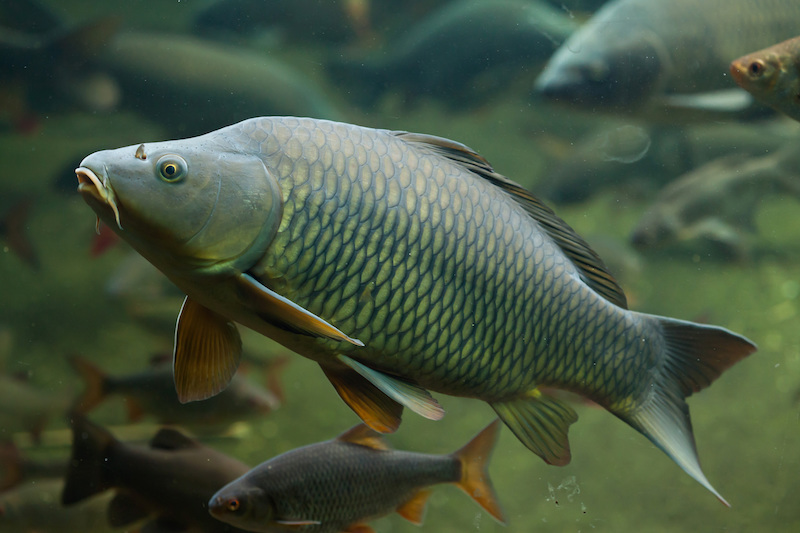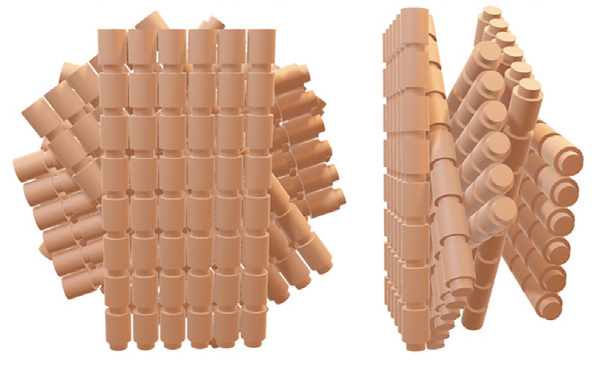SCIENTIFIC ACHIEVEMENT
Scientists have characterized carp scales down to the nanoscale, using the Advanced Light Source (ALS) to watch how the fibers in the scales react as stress is applied.
SIGNIFICANCE AND IMPACT
The resulting insights provide inspiration for the design of advanced synthetic structural materials with unprecedented toughness and penetration resistance.

Nature-inspired armor
Humans have drawn technological inspiration from fish scales going back to ancient times: Romans, Egyptians, and other civilizations would dress their warriors in scale armor, providing both protection and mobility. Now, using advanced x-ray imaging techniques, scientists have characterized carp scales down to the nanoscale, enabling them to understand how the material is resistant to penetration while retaining flexibility.
The researchers used powerful x-ray beams at the ALS to watch how the fibers in carp scales react as stress is applied. What they found may well provide further inspiration for the design of advanced synthetic structural materials with unprecedented toughness and penetration resistance.
Adaptive reorientation

Fish scales have a hard outer shell with a softer inner layer that is tough and ductile. When something tries to penetrate the scales—a predator’s teeth, for example—the outer shell resists but the inner layer has to absorb the excess load to keep the scale in one piece. How does it do this? It turns out that the fibers inside the scale are made up of fibrils (sub-fibers) of collagen molecules plus minerals. These fibrils are aligned in layers, with the fibril “grain” in each successive layer rotated by roughly 36 degrees (a “Bouligand structure”). When stress is applied to the material, the fibers rotate in sequence to absorb the excess load—a process known as adaptive reorientation.
In previous work, the researchers studied this process in the arapaima, an Amazonian freshwater fish whose scales are so tough they are impenetrable to piranha, as well as other species. In this work, they studied the carp, a modern version of the ancient coelacanth fish, also known for having scales that act as armor.
Measuring change in situ
At ALS Beamline 7.3.3, the researchers used small-angle x-ray scattering (SAXS) to measure nanometer-scale structural changes in scale specimens as they were stretched in situ. The scattering works because collagen fibrils have a banded structure with a periodic d-spacing, due to the way in which the collagen molecules bundle together. This structural periodicity enables the collagen fibers to act as a molecular diffraction grating, generating a well-defined pattern that can be used for quantitative analysis. For example, the distance q between the beam center and the first-order arc in the diffraction pattern is inversely proportional to the fibril d-spacing. Thus, the elastic strain in the collagen fibrils can be measured based on changes in this distance.

Delocalizing the damage
Analysis of the SAXS results revealed the sequence of deformation mechanisms experienced by the Bouligand structures: layer rotation, fibril deformation and sliding, and delamination, all of which act to delocalize damage and maintain the integrity of the scale. Layers where the fibrils were closely aligned with the tensile direction rotated toward that direction and were stretched, while layers with fibrils oriented at larger angles from the loading direction rotated away from from that direction and were compressed. Taken together, these deformation mechanisms render the carp scale an excellent dermal armor, offering protection from predators without compromising flexibility. With appropriate advances in 3D printing, the researchers believe that mimicking these design strategies could lead to improved lightweight synthetic armors.

Contact: Robert O. Ritchie
Researchers: H. Quan, M. Lapeyriere, and M.A. Meyers (Univ. of California San Diego); W. Yang (Univ. of California San Diego and Berkeley Lab); E. Schaible (ALS); and R.O. Ritchie (Univ. of California Berkeley and Berkeley Lab).
Funding: Air Force Office of Scientific Research and National Institutes of Health. Operation of the ALS is supported by the U.S. Department of Energy, Office of Science, Basic Energy Sciences program.
Publication: H. Quan, W. Yang, M. Lapeyriere, E. Schaible, R.O. Ritchie, and M.A. Meyers, “Structure and Mechanical Adaptability of a Modern Elasmoid Fish Scale from the Common Carp,” Matter, doi:10.1016/j.matt.2020.05.011 (2020).
Adapted from the Berkeley Lab news release, “Off the Scales: Fish Armor Both Tough and Flexible.”
ALS SCIENCE HIGHLIGHT #425